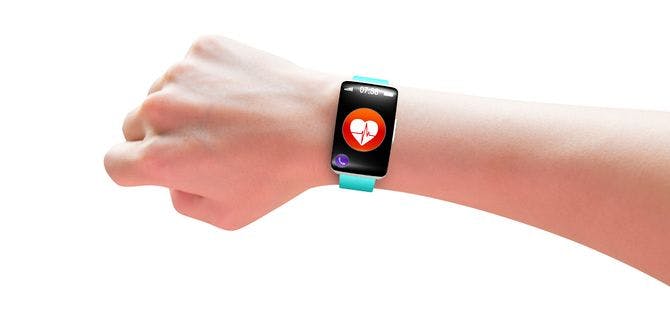Wearable biosensors are already available in consumer electronics, such as heart-rate monitors or fitness trackers. However, this is just a small part of the possibilities biosensor technologies offer. Of particular interest is the utility for biosensors that could monitor or even diagnose diseases. Biosensors act as a bridge, converting chemical information from within a biological […]

Wearable biosensors are already available in consumer electronics, such as heart-rate monitors or fitness trackers. However, this is just a small part of the possibilities biosensor technologies offer. Of particular interest is the utility for biosensors that could monitor or even diagnose diseases. Biosensors act as a bridge, converting chemical information from within a biological system into an electrical signal that we can capture and analyze. They are often made from linking a transducer with a recognition element – typically an enzyme, antibody or nucleic acid, and are increasingly being developed on a nanoscale.[1],[2] Single-use ingestible biosensors are being developed to make sure that medicines are taken – critical given that, on average, only half of prescribed medicines for chronic diseases are taken as they should be.[3] In this system, radio-frequency identification (RFID)-tagged capsules activate in the stomach to signal to a relay device, which in turn transmits a time-stamped message to a cloud-based server to log the patient’s adherence to their medication regimen.[4]
Future Applications of Biosensors
Researchers are working on measuring a person’s glucose levels via their tears using a flexible sensor, similar to a contact lens, made from nanoribbons of indium oxide, an enzyme glucose oxidase, a natural chitosan film and single-walled carbon nanotubes.[5] When glucose is present, the sensor sends an electrical signal. Testing showed that the device could detect a range of glucose concentrations from 10 nanomolar to 1 millimolar – sensitive enough to pick up the low levels of glucose in tears.12 This could offer continual glucose monitoring without relying on invasive finger prick measurements or cumbersome devices. To avoid the potential toxicity and life-cycle limits associated with traditional batteries, these kinds of long-term biosensors will need to be self-powered, using biofuel cells as a simultaneous power source and biosensor,[6],[7] or otherwise rely on technologies such as inductive coupling for wireless power transfer.[8]
Biosensors for Disease Detection
On an even deeper level, biosensors could be used to identify and diagnose diseases such as sepsis,[9] heart attacks,[10] and even cancer.[11],[12] At present, many cancers are not found until they are visible on imaging. Coupling biosensors with emerging biomarkers could allow fast and accurate detection of cancer,[13] and biosensors have even been developed that can report back on the biochemical properties of a single living cell,[14] detect gene mutations, or determine which specific drugs should be used to best attack tumors.9 Although single-use biosensors have established utility for diagnostics and reporting, there is a new drive to develop them for continuous, long-term use.[15] These tiny systems offer an incredible opportunity to tap into our bodies to get information – either as wearable or implanted tech or as a point-of-care diagnostic tool. New research in ACS Nano highlights the potential for biosensors in monitoring. Researchers may even develop chip-scale biosensor devices that could be placed in the human body to monitor vital signs, correct abnormalities, or even signal a call for help in an emergency9.
[1] Soleymani & Li. Mechanistic Challenges and Advantages of Biosensor Miniaturization into the Nanoscale. ACS Sens 2017;2(4):458–467.
[2] Zhang et al. Nanochannels Photoelectrochemical Biosensor. Anal Chem 2018;90(3):2341–2347.
[3] World Health Organization. ADHERENCE TO LONG-TERM THERAPIES: Evidence for action. Available at: http://www.who.int/chp/knowledge/publications/adherence_full_report.pdf?ua=1 (accessed March 2018).
[4] Chai et al. Utilizing an Ingestible Biosensor to Assess Real-Time Medication Adherence. J Med Toxicol 2015;11:439.
[5] Liu et al. Highly Sensitive and Wearable In2O3 Nanoribbon Transistor Biosensors with Integrated On-Chip Gate for Glucose Monitoring in Body Fluids. ACS Nano 2018;12(2):1170–1178.
[6] Sekretaryova et al. Cholesterol Self-Powered Biosensor. Anal Chem 2014;86(19):9540–9547.
[7] Grattieri & Minteer. Self-Powered Biosensors. ACS Sens 2018;3(1):44–53.
[8] Nukala et al. Efficient near-field inductive wireless power transfer for miniature implanted devices using strongly coupled magnetic resonance at 5.8GHz. IEEE Xplore 2016; doi: 10.1109/WMCaS.2016.7577481.
[9] Min et al. Integrated Biosensor for Rapid and Point-Of-Care Sepsis Diagnosis. ACS Nano 2018; doi: 10.1021/acsnano.7b08965.
[10] Liu et al. Highly Sensitive and Quick Detection of Acute Myocardial Infarction Biomarkers Using In2O3 Nanoribbon Biosensors Fabricated Using Shadow Masks. ACS Nano 2016;10(11):10117–10125.
[11] Huang et al. Nanotechnology-Enhanced No-Wash Biosensors for in Vitro Diagnostics of Cancer. ACS Nano 2017;11(6):5238–5292.
[12] Xu et al. Superwettable Electrochemical Biosensor toward Detection of Cancer Biomarkers. ACS Sens 2018;3(1):72–78.
[13] Bohunicky & Mousa. Biosensors: the new wave in cancer diagnosis. Nanotechnology, Science and Applications 2011;4:1–10.
[14] Zhang et al. Spearhead Nanometric Field-Effect Transistor Sensors for Single-Cell Analysis. ACS Nano 2016;10(3):3214–3221.
[15] Borman. A NonStop Biosensor. Chem Eng News 2013;91(49):9.